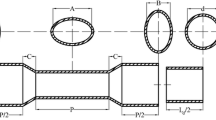Abstract
Results of numerical investigation of the boundary layer thickness on turbulent separation and heat transfer in a tube with an abrupt expansion are shown. The Menter turbulence model of shear stress transfer implemented in Fluent package was used for calculations. The range of Reynolds numbers was from 5·103 to 105. The air was used as the working fluid. A degree of tube expansion was (D 2/D 1)2 = 1.78. A significant effect of thickness of the separated boundary layer both on dynamic and thermal characteristics of the flow is shown. In particular, it was found that with an increase in the boundary layer thickness the recirculation zone increases, and the maximum heat transfer coefficient decreases.
Similar content being viewed by others

References
V.I. Terekhov, N.I. Yarygina, and R.F. Zhdanov, Heat transfer in turbulent separated flows in the presence of high free-stream turbulence, Int. J. Heat Mass Transfer, 2003, Vol. 46, P. 4535–4551.
A.M. Goorey, S.B. Watkins, and V. Aung, Turbulent heat-transfer computations for rearward-facing steps and sudden pipe expansions, J. Heat Transfer — Trans. ASME, 1985, Vol. 107, No. 1, P. 70–76.
V.E. Alemasov, G.A. Glebov, and A.P. Kozlov, Thermal-Anemometric Methods of Detached Flow Investigation, Kazan Branch of USSR Acad. Sci., Kazan, 1989.
D.E. Abbot and S.J. Kline, Experimental investigation of subsonic turbulent flow over single and double backward-facing steps, Trans. ASME, J. Basic Engng., 1962, Vol. 84, Ser. D, P. 317–325.
V. Kottke, Influence of temperature and concentration boundary layers at separation on heat and mass transfer in separated flows, in: Proc. Int. Heat Transfer Conf., Munich, 1982, Vol. 3, P. 177–182 (Paper FC32).
J.W. Bauhn, M.A. Hoffman, R.K. Takahashi, and B.E. Launder, Local heat-transfer downstream of an abrupt expansion in a circular channel with constant wall heat-flux, J. Heat Transfer — Trans. ASME, 1984, Vol. 106, No. 4, P. 789–796.
P.L. Komarov and A.F. Polyakov, Studying characteristics of turbulence and heat transfer behind a reverse step in a slot channel, Preprint of IHT AS No. 2-396, Moscow, 1996.
R.L. Webb, E.R.G. Eckert, and R.J. Goldstein, Heat transfer and friction in tubes with repeated-rib roughness, Int. J. Heat Mass Transfer, 1971, Vol. 14, P. 601–617.
J.K. Eaton, J.P. Johnston, A review of research on subsonic turbulent flow reattachment, AIAA J., 1981, Vol. 19, No. 9, P.1093–1100.
D.W. Ethereridge and P.H. Kemp, Measurements of turbulent flow downstream of a rearwarding-facing step, J. Fluid Mech., 1978, Vol. 86, Pt. 3, P. 545–566.
J.K. Eaton, J.P. Johnston, and A.N. Jeans, Measurements in a reattaching turbulent shear layer, in: Proc. 2nd Symp. of Turbulent Shear Flows, London, 1979.
M.A.B. Narayanan, Y.N. Khadgi, and P. Viswanath, Similarities in pressure distribution in separated flow behind backward-facing steps, Aeronaut. Quarterly, 1974, Vol. 25, P. 305–312.
S.R. Batenko and V.I. Terekhov, Effect of dynamic prehistory on aerodynamics of a laminar separated flow in a channel behind a rectangular backward-facing step, J. Appl. Mech. Tech. Phys., 2002, Vol. 43, No. 6, P. 854–860.
F.R. Menter, 2-equation eddy-viscosity turbulence models for engineering applications, AIAA J., 1994, Vol. 32, No. 8, P. 1598–1605.
A.Yu. Bystrov, S.A. Isaev, N.A. Kudryavtsev, and A.I. Leontiev, Numerical Simulation of Vortex Intensification of Heat Transfer in Tube Bundles, Sudostroenie, St. Petersburg, 2005.
T.V. Bogatko, Numerical investigation of heat transfer in a tube with diaphragms, in: Proc. IX All-Russ. School-Conf. of Young Scientists, Novosibirsk, 2006, P. 22–24.
E. Kondoh, Y. Nagano, and T. Tsuji, Computational study of laminar heat transfer downstream of a backwar-dfacing step, Int. J. Heat Mass Transfer, 1993, Vol. 36, P. 577–591.
A.I. Leontiev, V.I. Ivin, and L.V. Grekhov, Semi-empirical estimate method of the heat transfer level behind a detachment point of a boundary layer, J. Engng. Phys., 1984, Vol. 47, No. 4, P. 543–549.
T. Ota and H. Nishiyama, A correlation of maximum turbulent heat transfer coefficient in reattachment flow region, Int. J. Heat Mass Transfer, 1987, Vol. 30, No. 6, P. 1193–1200.
D.M. Kuehn, Some effects of adverse pressure gradient on the incompressible reattaching flow over rearward-facing step, AIAA J., 1980, Vol.18, No. 3, P. 343–344.
Author information
Authors and Affiliations
Additional information
The work was financially supported by the Russian Foundation for Basic Research (project codes 07-08-00025 and 06-08-00300).
Rights and permissions
About this article
Cite this article
Terekhov, V.I., Bogatko, T.V. Effect of boundary layer thickness before the flow separation on aerodynamic characteristics and heat transfer behind an abrupt expansion in a round tube. Thermophys. Aeromech. 15, 91–97 (2008). https://doi.org/10.1134/S0869864308010083
Received:
Published:
Issue Date:
DOI: https://doi.org/10.1134/S0869864308010083



